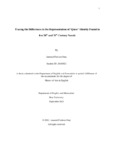| dc.contributor.advisor | Noman, Abu Sayeed Mohammad | |
| dc.contributor.author | Onty, Jannatul Ferdose | |
| dc.date.accessioned | 2022-02-06T08:38:10Z | |
| dc.date.available | 2022-02-06T08:38:10Z | |
| dc.date.copyright | 2021 | |
| dc.date.issued | 2021-09 | |
| dc.identifier.other | ID 20163021 | |
| dc.identifier.uri | http://hdl.handle.net/10361/16114 | |
| dc.description | This thesis report is submitted in partial fulfilment of the requirements for the degree of Masters of Arts in Teaching to Speakers of Other Languages, 2021. | en_US |
| dc.description | Cataloged from PDF version of thesis. | |
| dc.description | Includes bibliographical references (pages 37-38). | |
| dc.description.abstract | This paper aims to trace how the representation of „queer‟ characters in literature has metamorphosed over 20th to 21st century as traced in the novels Anne of Green Gables, Nightwood, Crossing and Call Me By Your Name. The portrayal of „queer‟ in the aforementioned novels is binary opposite and this change is the result of several movements on queer rights. It took hundreds of years of protests and rebellions for bringing this change. This paper is a neo-historical approach for depicting the gradual process of the evolution in the representation of „queer‟ in literature over the century, thus it includes brief history of several „queer‟ movements. This paper also shows the contrast of „homosexuals in denial‟ to „sexually fluid‟ characters in the aforementioned novels. | en_US |
| dc.description.statementofresponsibility | Jannatul Ferdose Onty | |
| dc.format.extent | 38 pages | |
| dc.language.iso | en | en_US |
| dc.publisher | Brac University | en_US |
| dc.rights | Brac University theses are protected by copyright. They may be viewed from this source for any purpose, but reproduction or distribution in any format is prohibited without written permission. | |
| dc.subject | Neo-historicism | en_US |
| dc.subject | Queer | en_US |
| dc.subject | Sexuality | en_US |
| dc.subject | Identity | en_US |
| dc.subject | Sexual fluidity | en_US |
| dc.subject | Movement | en_US |
| dc.subject | Self-acceptance | en_US |
| dc.subject | Gender binary | en_US |
| dc.subject.lcsh | Identity (Psychology) in literature. | |
| dc.title | Tracing the differences in the representation of ‘Queer’ identity found in few 20th and 21st Century novels | en_US |
| dc.type | Thesis | en_US |
| dc.contributor.department | Department of English and Humanities, Brac University | |
| dc.description.degree | M. in English | |

